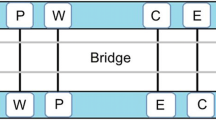Abstract
The effect of copper on survival, growth and feed intake of Indian major carp, Cirrhinus mrigala (Hamilton) fry (0.92 ± 0.28 g) was studied for 60 days. Survival rates of the fish exposed to control (0.02), 0.10, 0.15 and 0.23 mg L−1 copper were 100%, 83 ± 3%, 58 ± 6%, and 50 ± 4%, respectively. Average daily growth was significantly (p < 0.05) lower at 0.15 and 0.23 mg L−1 of copper. There was almost no growth at 0.23 mg L−1 of copper. Feed intake rates reduced significantly (p < 0.05) at all the copper treatments. The copper accumulation in the fish increased with increasing concentrations of the metal.

Similar content being viewed by others
References
Ali A, Al-Ogaily SM, Al-Asgah NA, Gropp J (2003) Effect of sublethal concentrations of copper on the growth performance of Oreochromis niloticus. J Appl Ichthyol 19:183–188. doi:10.1046/j.1439-0426.2003.00440.x
APHA (American Public Health Association) (1989) Standard methods for examination of water and wastewater, 17th edn. American Public Health Association, Washington, DC
Boeck GD, Vaeminck A, Blust R (2004) Effects of sublethal copper exposure on copper accumulation, food consumption, growth, energy stores, and nucleic acid content in common carp. Arch Environ Contam Toxicol 33:415–422. doi:10.1007/s002449900271
Buckley JT, Roch M, Mc Carter JA, Rendell CA, Matheson AT (1982) Chronic exposure of coho salmon to sublethal concentrations of copper. I. Effect on growth, on accumulation and distribution of copper, and on copper tolerance. Comp Biochem Physiol C 72(1):15–19. doi:10.1016/0306-4492(82)90198-8
Eisler R, Rossall RM, Gaboury GA (1979) Fourth annotated bibliography on biological effects of metals in aquatic environments, US Environmental Protection Agency Rs. R. P. EPA-600/3-79-084, Washington, DC
Fairweather-Tait SJ (1997) Bioavailability of copper. Eur J Clinical Nutr 51(suppl):S24–S26
Harris ED (1991) Copper transport: an overview. Proc Soc Exp Biol Med 196:130–140
James R, Sampath K, Edward DS (2003) Copper toxicity on growth and reproductive potential in an ornamental fish, Xiphophorus helleri. Asian Fish Sci 16:317–326
Jhingran VG (1991) Fish and fisheries of India. Hindustan Publishing Corporation, Delhi, p 727
Jhingran VG, Khan HA (1979) Synopsis of biological data on the mrigal, Cirrhinus mrigala (Hamilton, 1822). FAO Fisheries Synopsis, Rome, p 78
Kamunde C, Grosell M, Higgs D, Wood CM (2002) Copper metabolism in actively growing rainbow trout (oncorhynchus mykiss): copper uptake. J Exp Biol 205:279–290
Karakoc M (1999) Effects of salinity on the accumulation of copper in liver, gill and muscle tissues of Tilapia nilotica. Turk J Zool 23:299–303
Lanno RP, Slinger SJ, Hilton JW (1985) Maximum tolerable and toxicity levels of dietary copper in rainbow trout (Salmo girdneri, Richardson). Aquaculture 49:257–268. doi:10.1016/0044-8486(85)90084-5
Lauren DJ, McDonald DG (1985) Effects of copper on branchial ion regulation in the rainbow trout, Salmo gairdneri Richardson modulation by water hardness and pH. J Comp Physiol B 155:635–644. doi:10.1007/BF00694455
Linder MC (1991) Biochemistry of copper. Plenum Press, New York
Lopes PA, Pinheiro T, Santos MC, Mathias M, Collares-Pereira MJ, Viegas-Crespo AM (2001) Response of antioxidant enzymes in freshwater fish populations (Leuciscus alburnoides complex) to inorganic pollutants exposure. Sci Total Environ 280:153–163. doi:10.1016/S0048-9697(01)00822-1
Metelev VV, Kanaev AI, Dzaskhova NG (1983) Water toxicology. Amerind Publ Co Pvt Ltd, New Delhi
Ogino C, Yang GY (1980) Requirements of carp and rainbow trout for dietary manganese and copper. Bull Jap Soc Sci Fish 46:455–458
Pena MMO, Lee J, Thiele D (1999) A delicate balance: homeostatic control of copper uptake and distribution. J Nutr 129:1251–1260
Rath RK (1993) Freshwater aquaculture. Scientific Publishers, India
Satoh S, Yamamoto H, Takeuchi T (1983) Effects on growth and mineral composition of carp of deletion of trace elements or magnesium from fishmeal diet. Bull Jap Soc Sci Fish 49:431–435
Talwar PK, Jhingran AG (1991) Inland Fishes, vol I & II. IBH Publishing Co, Bombay
Uauy R, Olivares M, Gonzalez M (1998) Essentiality of copper in humans. Am J Clin Nutr 67(suppl):952S–959S
Varanka Z, Rojik I, Varanka I, Nemcosk J, Abraham M (2001) Biochemical and morphological changes in carp (Cyprinus carpio L.) liver following exposure to copper sulfate and tannic acid. Comp Biochem Physiol C 128:467–478
Watanabe T, Kiron V, Satoh S (1997) Trace minerals in fish nutrition. Aquaculture 151:185–207. doi:10.1016/S0044-8486(96)01503-7
Weinsberg F, Bickmeyer U, Wiegand H (1995) Effects of inorganic mercury (Hg2+) on calcium channel currents and catecholamine release from bovine chromaffin cells. Arch Toxicol 69:191–196. doi:10.1007/s002040050157
Wu SM, Jong KJ, Kuo SY (2003) Effects of copper sulfate on ion balance and growth in Tilapia larvae (Oreochromis mossambicus). Arch Environ Contam Toxicol 45:357–363
Author information
Authors and Affiliations
Corresponding author
Rights and permissions
About this article
Cite this article
Mohanty, M., Adhikari, S., Mohanty, P. et al. Role of Waterborne Copper on Survival, Growth and Feed Intake of Indian Major Carp, Cirrhinus mrigala Hamilton. Bull Environ Contam Toxicol 82, 559–563 (2009). https://doi.org/10.1007/s00128-009-9652-5
Received:
Accepted:
Published:
Issue Date:
DOI: https://doi.org/10.1007/s00128-009-9652-5




